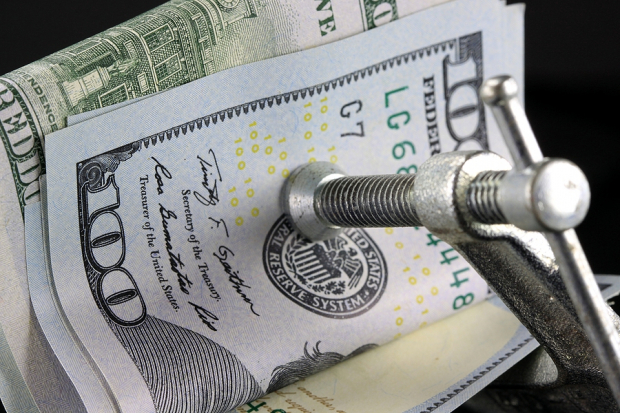
Driven by a mix of political and economic factors, the greenback is gradually losing its global dominance. Market sentiment regarding the increasing probability of the Fed cutting interest rates in the second half of 2024 and the momentum toward “de-dollarization” are shifting investors’ focus away from the greenback.
These factors increase the need for investors to diversify and hedge their portfolios by taking into account alternative currencies, as the currency market is often driven by investor sentiment instead of economic fundamentals of supply and demand.
Betting on Interest Cuts
The greenback’s value tends to move inversely with interest rate adjustments by the Fed. The rising probability of the Fed cutting interest rates from the second half of this year makes the dollar less attractive to foreign investors, resulting in decreased demand for the currency.
According to the CME FedWatch Tool, the Fed may begin reducing interest rates as early as June, with a 53.9% probability that they will decrease to 5-5.25%. The likelihood of rate cuts rises thereafter, with the rates potentially dropping to 4.25-4.5% by the end of the year, supported by a likelihood of 31.5%.
The chance of the Fed sticking to a dovish stance is strengthened by the recent inflation data. According to the Financial Times, inflation in the United States dropped in the month of January, reaching 2.4% from 2.6% in December. Following the news, the two-year Treasury yield, which correlates with interest rate expectations, dropped, ending the day 0.03 percentage points lower at 4.62%.
Pushing the Pace of De-dollarization
The macro environment and other economic factors are pushing economies to seek alternative currency options in a bid to reduce the global dominance of the greenback. This could result in the demand for the U.S. dollar decreasing, depreciating the currency.
Investors are turning their attention toward the Chinese yuan. The prospects for the country’s currency gets a boost from the fact that the Chinese policymakers will not allow the trade-dependent nation’s currency to depreciate below a threshold, which limits market pessimism, according to CNBC.
Rising U.S. debt levels may lead to challenges to the dollar’s global dominance, questioning its stability as a reliable anchor for the global monetary framework.
Per IMF, as quoted on Yahoo Finance, the U.S. dollar comprised 59.17% of global allocated foreign exchange reserves in the third quarter of 2023, and has lost around 6% of its share of global allocated foreign exchange reserves since 2016.
Alternative Route With Digital Currencies
De-dollarization and Fed rate cuts can also create opportunities in digital currencies. Bitcoin extended its winning momentum, surpassing the $63,000 mark on Wednesday and nearing a potential new record high. The upward momentum in the digital asset is further supported by the arrival of spot bitcoin ETFs (Read: Will Bitcoin Hit $200,000 in Current Bull Market? ETFs in Focus).
ETFs in Focus
Investors can look to hedge themselves against the likelihood of the greenback depreciating and diversify their portfolios by increasing their exposure to the following mentioned funds.
WisdomTree Emerging Currency Strategy Fund (CEW – Free Report)
WisdomTree Emerging Currency Strategy Fund employs an active strategy and provides exposure to various emerging currencies worldwide relative to the U.S. dollar, making it a quality fund to invest in emerging market nations.
The fund has exposure to currencies of Mexico, Colombia, Poland, Indonesia, Brazil and India, which comprise the top six countries, among others. The majority of the fund’s exposure is in Asia (50.36%), followed by South America (21.5%) and East Europe (14.41%).
WisdomTree Emerging Currency Strategy Fund has gathered an asset base of $7.1 million and charges an annual fee of 0.55%. The fund has gained 3.31% over the past three months and 3.62% over the past year.
Invesco DB U.S. Dollar Index Bearish Fund (UDN – Free Report)
Invesco DB U.S. Dollar Index Bearish Fund offers exposure to a basket of currencies relative to the greenback, rising when the dollar depreciates. UDN is an appropriate option for investors with a bearish outlook on the U.S. Dollar.
Invesco DB U.S. Dollar Index Bearish Fund has gained 4.12% over the three months and 1.58% over the past year.
Investors can also look into the following funds that provide exposure to the basket of currencies tracked by the U.S. Dollar Index (USDX), relative to the greenback, rising when the dollar depreciates.
Investors with a bearish outlook on the U.S. dollar can opt for these funds. Invesco Currencyshares Japanese Yen Trust (FXY), Invesco CurrencyShares Euro Currency Trust (FXE), Invesco CurrencyShares Canadian Dollar Trust (FXC), Invesco CurrencyShares Swiss Franc Trust (FXF – Free Report) and Invesco CurrencyShares British Pound Sterling Trust (FXB).
Digital Currencies
Below we highlight a few cryptocurrency ETFs that could be tapped now.
Grayscale Bitcoin Trust (GBTC – Free Report) – Up 80.45% over the past year
Bitwise Bitcoin Strategy Optimum Roll ETF (BITC – Free Report) – Up 12.74% over the past three months
Valkyrie Bitcoin and Ether Strategy ETF (BTF – Free Report) – Up 69.67% over the past year
ProShares Ether Strategy ETF (EETH – Free Report) – Up 21.75% over the past three months
Want key ETF info delivered straight to your inbox?
Zacks’ free Fund Newsletter will brief you on top news and analysis, as well as top-performing ETFs, each week.
